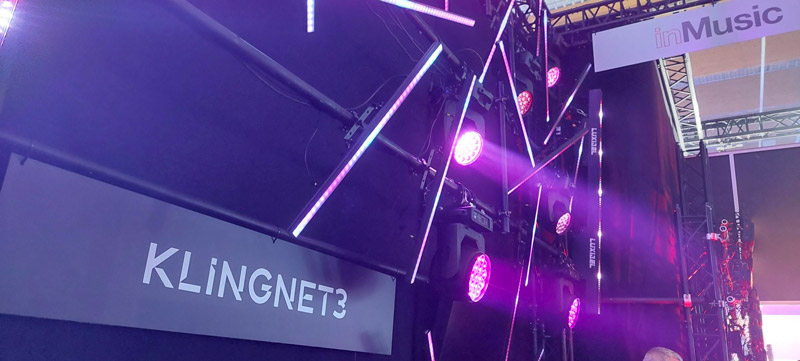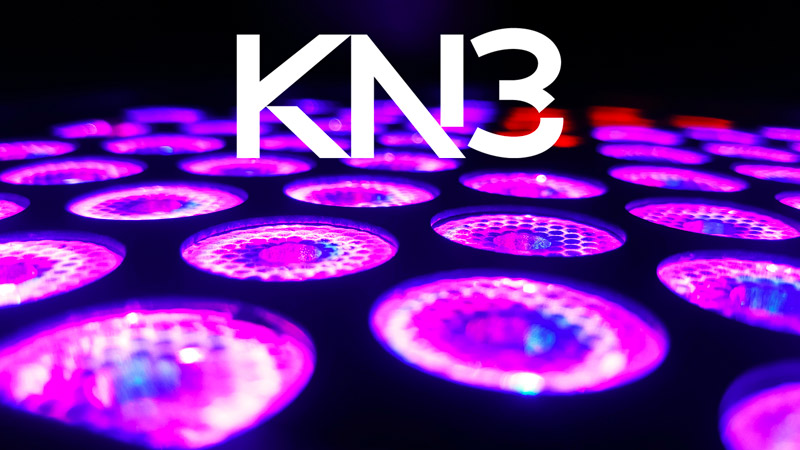
KlingNet3 is a new flexible, cloud-compatible, lighting and visual
control protocol for the future developed by InMusic Brand’s ArKaos for the entertainment industry.
It takes flexibility, user-friendliness, feedback, and ultimate control to next-gen levels.
What's New
KlingNet3 (patent pending) enables control of ALL parameters of a lighting fixture – and so much more – and is a viable alternative to DMX.
KlingNet3 unleashed major additional features like the auto-detection of fixtures / fixture types on the network; the facilitation of software updates; remote mode switching and numerous other functions, a long list crunched from the wishes and demands of lighting and visual designers, programmers and end-users combined with extensive research over the last three years.
Based on standard Cloud technologies, KlingNet3 is made to manage more data than even the largest shows currently utilize – it is built for the future.
Manufacturers will have the option of choosing which KlingNet3 protocol features they enable on their new products.
As an important feature, the entire fixture personality is held within the fixture and shared over the protocol with the lighting consoles and media servers.
A full 3D mesh model can be held within the fixture information on the system and made available for visualisers and tracking systems, together with all the relevant colour information, links to the manual and details of all gobo, animation wheel and other effects, allowing the motion and effects of the fixture to be accurately modelled in the visualiser.
A ‘Closed Loop Control Mode’ enables the console to acquire all actual values of the fixture but also allows for the sending of a warning to the console if anything is out of place.
This detailed feedback information can relate to specific parameters and can include elements like voltages, current, lamp power, the hours a light source has been running, RPM of the fans, internal temperature, etc – a host of invaluable information for systems techs – all of which will be communicated via KlingNet3.
Licensing and Cloud
KlingNet3 will be available under licence similar to KlingNet2 and has been designed to be ultimately affordable to all.
InMusic’s thinking behind it is to democratise and to make lighting control as straightforward to set up as a smart light / one button touch system. Quick, simple, and reliable, working every time.
When fixtures are connected to the same computer network, they are auto-detected by the system, added to the control console and are immediately available for control.
KlingNet3 facilitates multi-user scenarios for broadcast, complex live shows, festivals, and multi-artist line ups, where there will often be several consoles in operation or in session.
Fixture parameters can be split so selected elements can be controlled – for example – by remote follow spot operators, while others related to the same light can be run from the lighting console.
Designed from the outset to be cloud-compatible, this allows all KlingNet3 features to be bridged via the Cloud, perfect for multi-site control and joy to the ears of installers needing to painlessly implement software updates or pre-emptive maintenance.
It supports live streaming, so local lighting fixtures can be synched to a global system coming from the host stream via the cloud.
The cloud infrastructure also means detailed data can be harvested via KlingNet3 so manufacturers can effectively see how their kit is being used after it is sold. It will record how many times parameters like shuttering, gobos, prisms, etc., are utilised by end users, which can be helpful in fine-tuning future R ‘n’ D plans.
The standard for pixel control
ArKaos has originally designed the Kling-Net protocol over 12 year ago to allow the distribution of real-time video data to
remote display devices, such as LEDs or LED panels, over Ethernet.
Many first time users are
afraid of using LED lighting because of the complexity of networking and control issues. Using and
networking LED lighting has required a high level of technical knowledge which has been a deterent for
many.
We wanted to remove all this complexity and replace it with an easy protocol which automatically takes care of the magic numbers for the user!
The purpose of Kling-Net is:
- To allow the automatic configuration and connection of display devices to a computer
- To add some ‘intelligence’ into display devices, which enables auto configuration
- To ensure a perfect time synchronization of multiple display devices
- To avoid using expensive hardware video converters to send video to display devices
- To allow the creation of an heterogenic network of display devices from different manufacturers, which can all be controlled from one computer
Easier than ever
Kling-Net uses a Media Server to do all the work, making operation simpler than ever. It adds a layer of ‘intelligence’ to even the most simple LED device, enabling it to talk directly to the Media Server.
This then enables the LED devices to configure themselves automatically, removing the need for complicated setup processes.
Auto Configuration
Kling-Net’s auto configuration capabilities allow a large range of devices to be controlled by the same Media Server, thus avoiding the painful process of creating and matching profiles between the Media Server and each individual device.
At power up, the LED devices are detected and configured automatically by Kling-Net before sending their resolution and pixel format to the Media Server. The Media Server can then read and change parameters from the device. This makes the whole process extremely fast and easy, while minimising the potential for mistakes!
Once a device is registered to a Media Server, it will start receiving video frames, as mapped by the user onto the Media Server’s display, in real-time.
Because the Media Server performs the image clipping and transformation then outputs the correct pixel format, the work to be done by the display device is minimal. And since the Media Server does all the work, your video can play at a smooth 60 FPS.
Added Intelligence = Simplicity = Economy
In order to allow auto configuration of display devices, some intelligence needs to be added to standard LED devices. A small micro controller is used to implement the support of the few network messages exchanged with the Media Server. That processor is very inexpensive to ensure a low cost duplication for the manufacturers.
Network messages are managed by the Media Server and sent as either Broadcast or Unicast messages, with the default being Unicast to optimize the amount of ‘traffic’ and minimise the load of the receiver. Kling-Net also has robust error recovery enabling the Media Server to automatically reconnect.
Kling-Net brings LED lighting within reach of the smallest clubs and venues by making it less technical and less expensive. LED lighting is now easy to use and cost effective; thanks to the Kling-Net protocol you no longer have to use expensive devices to obtain sophisticated control.
Universal Application
Kling-Net has been designed to work with mostly any manufacturers’ LED products. It relies on a source code which is capable of transforming even the most simple LED device into an intelligent Kling-Net device.




